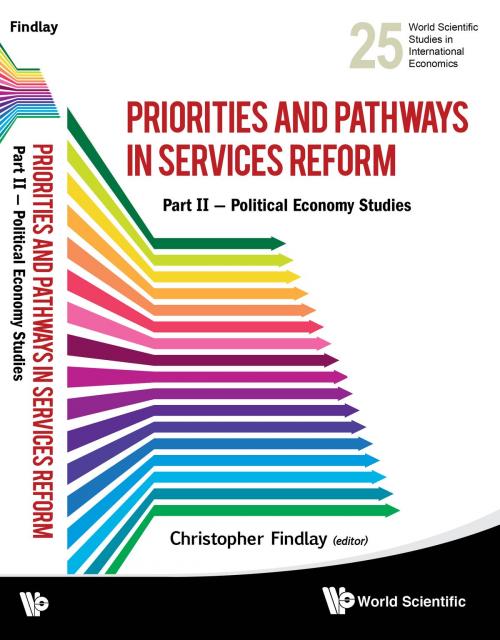Priorities and Pathways in Services Reform — Part II
Political Economy Studies
Nonfiction, Social & Cultural Studies, Political Science, Politics, Economic Conditions, Business & Finance, Industries & Professions, Industries| Author: | Christopher Findlay | ISBN: | 9789814504706 |
| Publisher: | World Scientific Publishing Company | Publication: | October 10, 2013 |
| Imprint: | WSPC | Language: | English |
| Author: | Christopher Findlay |
| ISBN: | 9789814504706 |
| Publisher: | World Scientific Publishing Company |
| Publication: | October 10, 2013 |
| Imprint: | WSPC |
| Language: | English |
Services markets remain highly regulated and international trade and investment is restricted. Previous works have identified the scope for significant gains from trade, yet those results are often debated and the progress on reform has been slow. Parts I and II in Priorities and Pathways in Services Reform help fill the gap in the research around this debate. Part I — Quantitative Studies contains up-to-date assessment and evaluations of the impact of policy in a range of services markets in different countries (through cross-country modelling of the impacts of a reform program). Part II — Political Economy Studies builds on this to address the understanding of what makes a reform successful, going beyond a quantification of the benefits of reform. This book fills that gap by reporting and reviewing the experience of reform across different sectors and countries. Ten key lessons are identified for successful reform. Readers will find fresh insights into managing complex issues in services reform.
You may also be interested in Priorities and Pathways in Services Reform: Part I — Quantitative Studies.
Contents:
- Overview (Christopher Findlay)
- Telecommunications in Papua New Guinea (Ronald Duncan)
- Gas in Thailand (Deunden Nikomborirak)
- Electricity in Russia (Alexandra Sidorenko)
- Electricity in Korea (Seung-Hoon Lee)
- Rail Transport in Chile (Raimundo Soto)
- Rail Transport in New Zealand (Dave Heatley and Margot Schwass)
- Maritime Transport in Australia and the United States (Fabien Bertho)
- Road Transport in Thailand (Narong Pomlaktong, Rattana Jongwilaiwan, Prakai Theerawattanakul and Rapee Pholpanich)
- China's Services Policy Reform Before and After the Global Financial Crisis (Fan Ying)
- Services Sector Reforms in India: Update and Challenges (Rupa Chanda and Pralok Gupta)
- Services Trade Reform in the European Union — The EU Services Directive (Anne McNaughton and Paul Furlong)
Readership: Applied economists, graduate students, researchers, professionals and policy advisors in the areas of structural reform and economic integration.
Key Features:
- Identifies ten key lessons for successful reform by bringing together studies of different sectors across various countries
- Provides fresh insights into managing complex issues in services reform, above and beyond quantifying the benefits of reform
Services markets remain highly regulated and international trade and investment is restricted. Previous works have identified the scope for significant gains from trade, yet those results are often debated and the progress on reform has been slow. Parts I and II in Priorities and Pathways in Services Reform help fill the gap in the research around this debate. Part I — Quantitative Studies contains up-to-date assessment and evaluations of the impact of policy in a range of services markets in different countries (through cross-country modelling of the impacts of a reform program). Part II — Political Economy Studies builds on this to address the understanding of what makes a reform successful, going beyond a quantification of the benefits of reform. This book fills that gap by reporting and reviewing the experience of reform across different sectors and countries. Ten key lessons are identified for successful reform. Readers will find fresh insights into managing complex issues in services reform.
You may also be interested in Priorities and Pathways in Services Reform: Part I — Quantitative Studies.
Contents:
- Overview (Christopher Findlay)
- Telecommunications in Papua New Guinea (Ronald Duncan)
- Gas in Thailand (Deunden Nikomborirak)
- Electricity in Russia (Alexandra Sidorenko)
- Electricity in Korea (Seung-Hoon Lee)
- Rail Transport in Chile (Raimundo Soto)
- Rail Transport in New Zealand (Dave Heatley and Margot Schwass)
- Maritime Transport in Australia and the United States (Fabien Bertho)
- Road Transport in Thailand (Narong Pomlaktong, Rattana Jongwilaiwan, Prakai Theerawattanakul and Rapee Pholpanich)
- China's Services Policy Reform Before and After the Global Financial Crisis (Fan Ying)
- Services Sector Reforms in India: Update and Challenges (Rupa Chanda and Pralok Gupta)
- Services Trade Reform in the European Union — The EU Services Directive (Anne McNaughton and Paul Furlong)
Readership: Applied economists, graduate students, researchers, professionals and policy advisors in the areas of structural reform and economic integration.
Key Features:
- Identifies ten key lessons for successful reform by bringing together studies of different sectors across various countries
- Provides fresh insights into managing complex issues in services reform, above and beyond quantifying the benefits of reform















